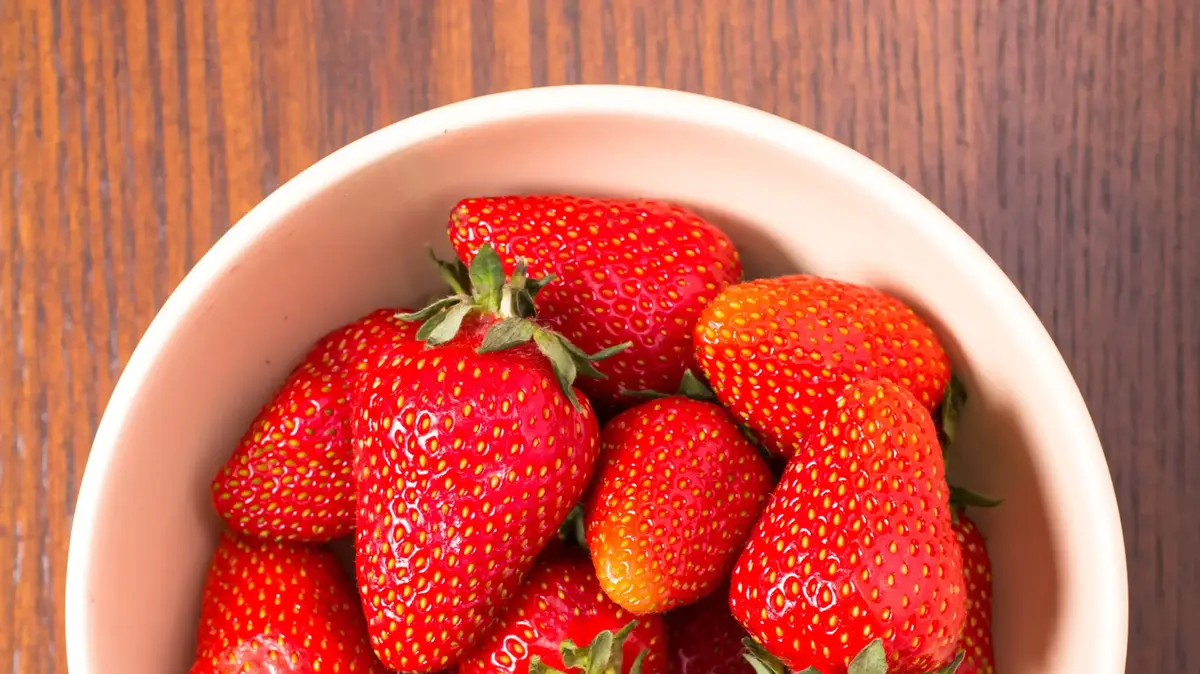Strawberry picking in Moshav Tsovit (photo: Yossi Tsipkis, editing: Avitar Halimi)
There is nothing like a ripe and cool strawberry on an annoying day (and whipped cream is a must).
Unlike many other fruits, fresh strawberries are an expensive commodity and there is nothing worse than finding out that the strawberries we bought fully ripe went bad in the fridge within two days.
"It's a disappointing situation that I've experienced one too many times," says Thekitchn.com's Jesse Shevchik, "It's a problem I was determined to solve."
In an attempt to not throw away any more spoiled strawberries into the world, Jesse put 7 popular methods of storing them to the test.
He followed the instructions and every morning rechecked the condition of the strawberries he had stored.
Any strawberry that started to soften or turn a burgundy/brown color was counted as "spoilt" for the purpose of testing ("But don't worry," he says, "I used them to make homemade jam").
At the end of the week he counted how many strawberries he had spoiled and announced the winning method.
Some storage methods worked better than others, but there was one that won out and kept the strawberries fresh for an entire week: soaking them in a vinegar-water solution.
"The winning method has now become my choice for storing all the variety of fresh berries I purchase," he said.
More about the winning method, about others that were almost as good as it (and more effective in case you are pressed for time) and about those that were hugely disappointing in his full findings below:
1. Removing the leaves, cutting in half and storing in the refrigerator with the cut side down
How many spoiled: 100% of the strawberries.
Rating: 1/10.
"In an attempt to make access to strawberries as easy as possible, I tested the impossible and pre-peeled the leaves from an entire box of strawberries to see if they would hold up," Jesse wrote.
He removed the stem from them, cut them in half and stored them in a tray in a row with the cut side down.
He put the mold in the refrigerator without a cover and checked their condition every day.
He said: "It was a wild idea, but I wanted ready-to-eat strawberries."
More on the same topic
The simple trick to keeping strawberries fresh (and the clean way to eat them)
To the full article
Unfortunately, after seven days all the strawberries went bad.
They dried and shriveled - and the cut edge turned gray.
"I knew it wouldn't work and I was still disappointed," he added, "Pre-cutting strawberries is a bad idea. The cut sides end up browning, mushy and looking bad. Some methods online recommend storing pre-peeled strawberries in Ziploc bags on top of a paper towel, so it might be It's my mistake that I did it that way."
He concludes: "Either way, I don't expect strawberries cut in half to survive more than a week in the refrigerator."
2. Dip in hot water and store on paper towels in an airtight container
How many spoiled: about 60% of the strawberries.
Rating: 3/10.
This method came from the well-known food book author, Harold McGee, who specializes in the connection between food science and cooking.
"His book 'On Food and Cooking' is considered one of the ultimate culinary science resources, so I knew we had to include his method as part of the experiment," Jesse said.
His method involves soaking the strawberries in a pot with water at a temperature of 50 degrees Celsius (which is hot but not boiling) for 30 seconds and then transferring them to a tray lined with paper towel and putting them in the refrigerator.
Soaking them in hot water is said to suppress mold growth and make the strawberries last longer.
"By the seventh day, just over half of the strawberries had gone bad - which was surprising considering how much effort (and science!) had gone into developing this storage method," said Jesse, "It didn't really seem like the hot water bath was doing its job and most of the strawberries looked pretty bad ".
More storage secrets
from ketchup to honey:
Here's how to keep your avocados ripe for a whole year
Jesse concluded: "This method was a bit of a project and I don't think it was worth the extra time and effort it required. I didn't see much (if any) improvement in terms of how long the strawberries lasted and I don't Would recommend taking the extra time to make it. I don't think it worked because the strawberries were too wet, which made them go bad faster. By the end of the week the paper towel was damp and seemed to only contribute to their bad state, so maybe I didn't give the strawberries time to dry before I put them in in the fridge".
@shazoshop4u Food Storage Hack that actually Works #KitchenHack #LifeHack #foodhacks #fyp #asmr #HowTo #beforeandafter #foodstorage ♬ original sound - shazoshop4u
3. Washing and storing over paper towels
How many spoiled: about 40% of the strawberries.
Rating: 5/10.
One of the most popular methods of storing strawberries is to simply wash them and store them in a container lined with a paper towel.
This way you can shove a strawberry in your mouth every time you crave one (or ten) without having to wash them a moment before.
For the test Jesse washed strawberries, placed them in a dish lined with absorbent paper, covered them and stored them in the refrigerator.
By the end of the week, just under half of the strawberries had gone bad.
The paper towel was wet and the parts of the strawberries that touched it seemed to spoil faster.
"Storing wet strawberries in the refrigerator proved once again to be a recipe for disaster. In the end the paper towel got wet and the strawberries spoiled pretty quickly," Jesse concluded, "By the fifth day I could already tell that this method doesn't work that well. No matter how you choose to store your strawberries - make sure that they are completely dry before you put them in the fridge."
@jenneatsgoood always makes them last longer!
#kitchenhacks #kitchenhack #cookinghacks #cookinghack #mealprep #MoveWithTommy #takeaNAIRbreak #strawberries ♬ Love You So - The King Khan & BBQ Show
4. Store in an airtight glass jar
How many spoiled: about 30% of the strawberries.
Rating: 6/10.
Many experts suggest storing fresh strawberries in an airtight glass jar (like a mason jar).
Just put the unwashed strawberries straight into the jar, close it tightly and put it in the fridge.
Some experts claim that this method will keep the strawberries fresh for up to two weeks.
By the end of the week only a third of the strawberries showed any signs of rot.
The sealed jar seems to keep the strawberries fresher much longer than storing them in an uncovered pan.
The strawberries at the bottom of the jar looked less good than the ones on top, but "that's probably because they were carrying the weight of the other strawberries on top," Jesse added, "However, overall they stayed pretty fresh."
Jesse concluded: "Although it was a bit difficult to get the strawberries in and out of the jar, this method worked surprisingly well. The jar kept the strawberries relatively fresh. The jar unfortunately cannot hold a kilo of strawberries, so although the method is successful, I think it is less practical ".
@tastyentertaining Keep strawberries fresh longer!
#newyear #kitchenhacksthatwork #tiktoknana #storagehacks ♬ Happy - Pharrell Williams
5. No washing and storage on paper towels
How many spoiled: about 20% of the strawberries.
Rating: 7/10.
After Jesse was disappointed to discover how easily washed strawberries on paper towels go bad, he tried to test it without washing them and was pleasantly surprised.
He placed the unwashed strawberries in a dish lined with a paper towel, covered them and put them in the fridge.
By the end of the week the paper towel had absorbed a decent amount of liquid and was stained red in some places - indicating that it had absorbed some of the excess liquid that would have caused the strawberries to spoil faster if it hadn't been there.
On the seventh day, only about a fifth of the strawberries spoiled.
"This method worked significantly better than storing washed strawberries on paper towels," said Jesse, "This proves that the condition of the strawberries - wet or dry - plays a significant role in keeping them fresh."
He concluded: "This method worked well and resulted in a smaller amount of spoiled strawberries, but I wouldn't call it a real discovery."
A woman eating a strawberry (Photo: Giphy)
6. Sorted and returned to their original packaging
How many spoiled: about 15% of the strawberries.
Rating: 8/10.
"We included this method as a control to judge the rest of the tests we did," explained Jesse, "We sorted the strawberries, threw away any strawberries that didn't look good and returned the good ones to the original packaging, which we stored in the refrigerator."
"To my surprise, on the seventh day almost none of the strawberries had gone bad. Almost all of them were still fresh and delicious - and only a few showed signs of aging. This method was by far the easiest and the results were pretty great. The original packaging kept the strawberries fresh much better than most other storage containers - and it didn't take long."
Jesse concluded: "Make sure the strawberries are dry and put them back in the package - it seems to give them enough air circulation without exposing them too much. If you're pressed for time, storing strawberries in their original packaging works great."
7. Soak in a vinegar solution and dry in a salad spinner
How many spoiled: about 5% of the strawberries.
Rating: 9.5/10.
"This is one of the most common methods I've seen online and I was eager to try it," Jesse wrote.
All you have to do is dip the strawberries in a bowl of water with white vinegar (about a quarter of white vinegar and three quarters of water), filter and dry them as thoroughly as possible.
"Food52 suggests drying them in a dehydrator lined with paper towels to ensure they dry out, so that's exactly what I did," said Jesse, "After drying, transfer the strawberries to a container lined with a paper towel, loosely place the lid (no seal it) and put it in the refrigerator."
Jesse concluded: "By the end of the week, almost none of the strawberries had gone bad. I didn't have to throw any away and there might have been a few dark spots here and there, but nothing serious. And because the strawberries were thoroughly dried in a salad spinner, the paper towel remained almost completely dry on the seventh day . However, this method takes time and effort. If you have a lot of strawberries and they were expensive - it's definitely worth it. The strawberries stayed fresh, juicy and firm all week and showed almost no signs of spoilage. They looked like I had just bought them and were fresh (almost ) as on the first day".
@beckababess Hope this helps!
#fyp #smallbusinesscheck #valentinesday #chocolatecoveredstrawberries #tips #strawberries #tiktoksweets ♬ Aesthetic - Xilo
In conclusion, says Jesse of Thekitchn.com, "Moisture is strawberries' biggest enemy. If you want to make sure your strawberries are completely dry before you put them in the fridge, I suggest holding off on washing them until you're ready to eat them—or drying them thoroughly in a spinner. If you're pressed for time, just store the strawberries in their original packaging, after discarding any that are on the verge of spoiling. If you have time, soak them in a vinegar-water solution and dry them afterwards. This is a great way to extend their shelf life."
Food
The food news
Tags
strawberries








